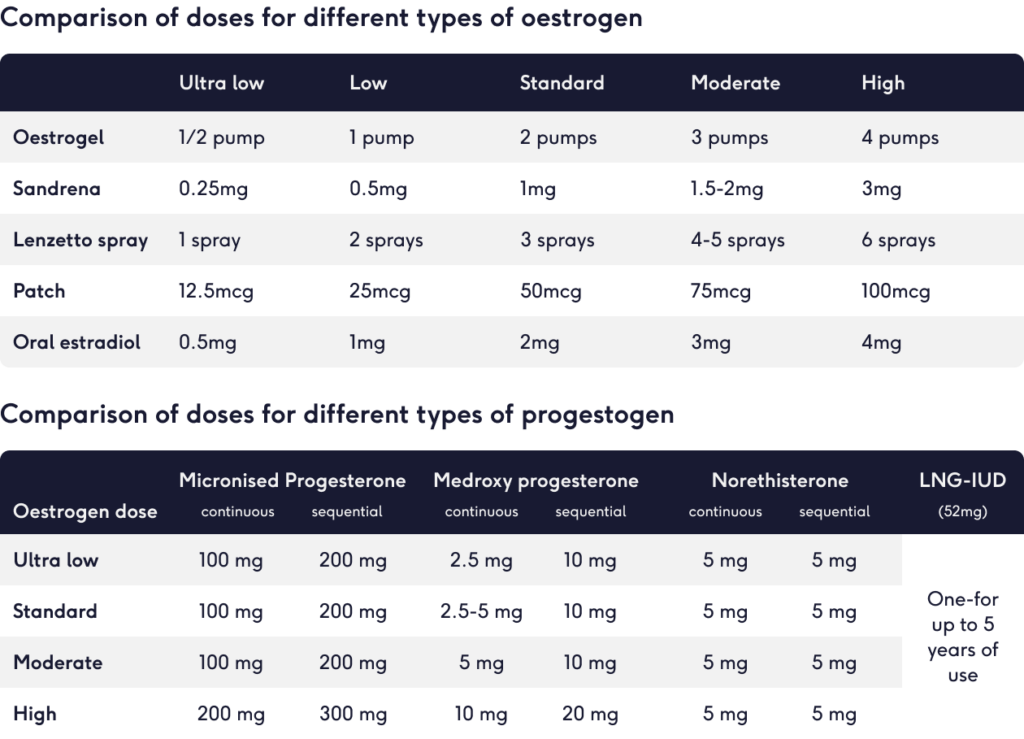
HRT and Progesterone – the facts
What is HRT?
HRT stands for hormone replacement therapy. This is a medication used to treat perimenopausal and menopausal symptoms. It is an amazing treatment for hot flushes and the mood and anxiety symptoms of menopause. HRT can also have long term benefits to your health. HRT can protect your bones from thinning and reduce the risk of heart attacks or strokes. This is if you start it within 10 years of your last period and before the age of 60. HRT can have some small risks. For the majority of people using HRT, the benefits of it far outweighs these small risks. This blog will talk about the risk of oestrogen on your womb and the importance of progesterone in HRT.
Why do you need oestrogen and progesterone in HRT?
Most of your peri and menopausal symptoms are due to decreasing levels of oestrogen in your body. HRT replaces this oestrogen to make you feel better! But, if you have a uterus, you must also have progesterone in your HRT. This is because oestrogen can cause your womb lining to thicken and overgrow. There is a risk that over many years, this can develop into cancer. Progesterone thins the womb lining, so protects your womb lining from the oestrogen.
What is endometrial protection?
Endometrial protection, or womb protection, is the medical description for making sure that you have the right amount of progesterone in your HRT to stop your womb lining from overgrowing and increasing the risk of cancer. The endometrium is the medical word for the lining of the uterus or womb.
What happens if you only take oestrogen without progesterone?
If you just take oestrogen without any progesterone, this increases the risk of overgrowth of your womb lining which can develop into cancer. Oestrogen only HRT is therefore only usually given to those who have had a hysterectomy (surgery to remove their womb). If you have a womb, taking progesterone keeps the womb lining thin, or allows your womb lining to be shed as a bleed each month, protecting the womb lining from the effects of oestrogen.
How much progesterone should I take for HRT?
The amount of progesterone you should take as part of your HRT depends on the type of progesterone you are using and the dose of oestrogen you are using. Using the hormonal coil is easy, the same dose of hormonal coil (containing 52 mg of levonorgestrel) is used for all oestrogen doses. If you are using a combined tablet or patch, these usually have the perfect dose of progesterone for your oestrogen together in one tablet or patch. However, if you choose to take your progesterone separately from your oestrogen, it’s really important to know the levels that are needed for each dose of oestrogen. Your doctor or nurse should do this but you can check you are on the right dose using the tables below.

What is cyclical or continuous progesterone?
Cyclical (also called sequential) HRT is when the progesterone hormone is only taken for part of the cycle, and you will usually have a monthly bleed. You will usually start with this if you are perimenopausal and still having periods when you start HRT. The number of days you need to take progesterone, and the dose required, varies between different types of progesterone and your oestrogen dose. Your healthcare professional will explain the correct dose and number of days to take it. Continuous HRT is when progesterone is taken at the same dose every day, and is designed to prevent bleeding. If you’ve not had a period for over a year when you start HRT you will usually start continuous HRT.
When should I switch between cyclical and continuous progesterone?
If you are using cyclical or sequential HRT, the British Menopause Society recommends you should switch to continuous HRT when you are 54 years old, or (if you are over the age of 45) have used cyclical HRT for 5 years. Continuous HRT is better at protecting your womb lining from overgrowing and developing into cancer, and that is why this switch is recommended.
What happens if I take too much progesterone?
If you accidentally take an extra dose of progesterone, it is unlikely to cause any problems. The main problem with progesterone is the side effects. These can include anxiety, mood change, PMS like symptoms, breast tenderness, bleeding and bloating. Some progesterones, especially Utrogestan, can cause drowsiness.
What are the side effects of progesterone in HRT?
Each person will experience side effects of progesterone differently. The common side effects include:
- Irregular bleeding
- Headaches
- Bloating
- Mood changes and anxiety
- Acne
- PMS like symptoms
- Breast pain and tenderness
- Drowsiness
How do I know if I am progesterone sensitive or intolerant?
You may be sensitive or intolerant to progesterone if you start to have severe side effects soon after starting HRT containing progesterone. Intolerance to progesterone might be more likely if you have suffered with hormonal problems in the past such as PMS, postnatal depression or side effects to hormonal contraceptives.
For most people, the side effects start to reduce after time, so if you can stick them out for a few weeks they usually get better. However, if the side effects are having a huge impact on your life, please speak to your healthcare professiona. Remember, the progesterone part of your HRT is very important, so please get support and do not change the dose yourself or stop taking it altogether.
What can I do if I am progesterone sensitive or intolerant?
If you are sensitive to the progesterone part of HRT, please speak to your healthcare professional. Progesterones can be given in different ways which may improve your side effects, for example, given vaginally rather than orally. And there are lots of different types of progesterone, so you can try other options. For example, some of the older progesterones are better at stopping bleeding side effects than the newer ones. It may be a bit of trial and error, but most people can find something that suits them. If you need support with this, our menopause specialist partners Stella are here to help.
What is the difference between synthetic and body identical progesterone in HRT?
The difference between synthetic and body identical progesterone is their chemical structure. Synthetic progesterones are also called progestogens in the UK or progestins in the US. They have been made for many years in labs. The chemical structure of synthetic progesterones is very slightly different from the natural progesterone that our body makes. Therefore, these synthetic progesterones can cause slightly different side effects.
Body identical progesterones, like Utrogestan or in Bijuve, have the exact same chemical structure as the progesterone our body makes. However, they are still made in a lab from sweet potatoes or yams! Body identical progesterones may have fewer side effects and don’t increase your risk of breast cancer for at least 5 years of use.
There is no right or wrong choice between synthetic or body identical progesterones, you can choose which type you use as an individual based on your side effects and preferences. We’ve made it easy to do your own research on The Lowdown’s HRT platform, by including whether the hormone is body identical or synthetic on each HRT brand you search!
Our medical review process
This article has been medically reviewed for factual and up to date information by a Lowdown doctor.






